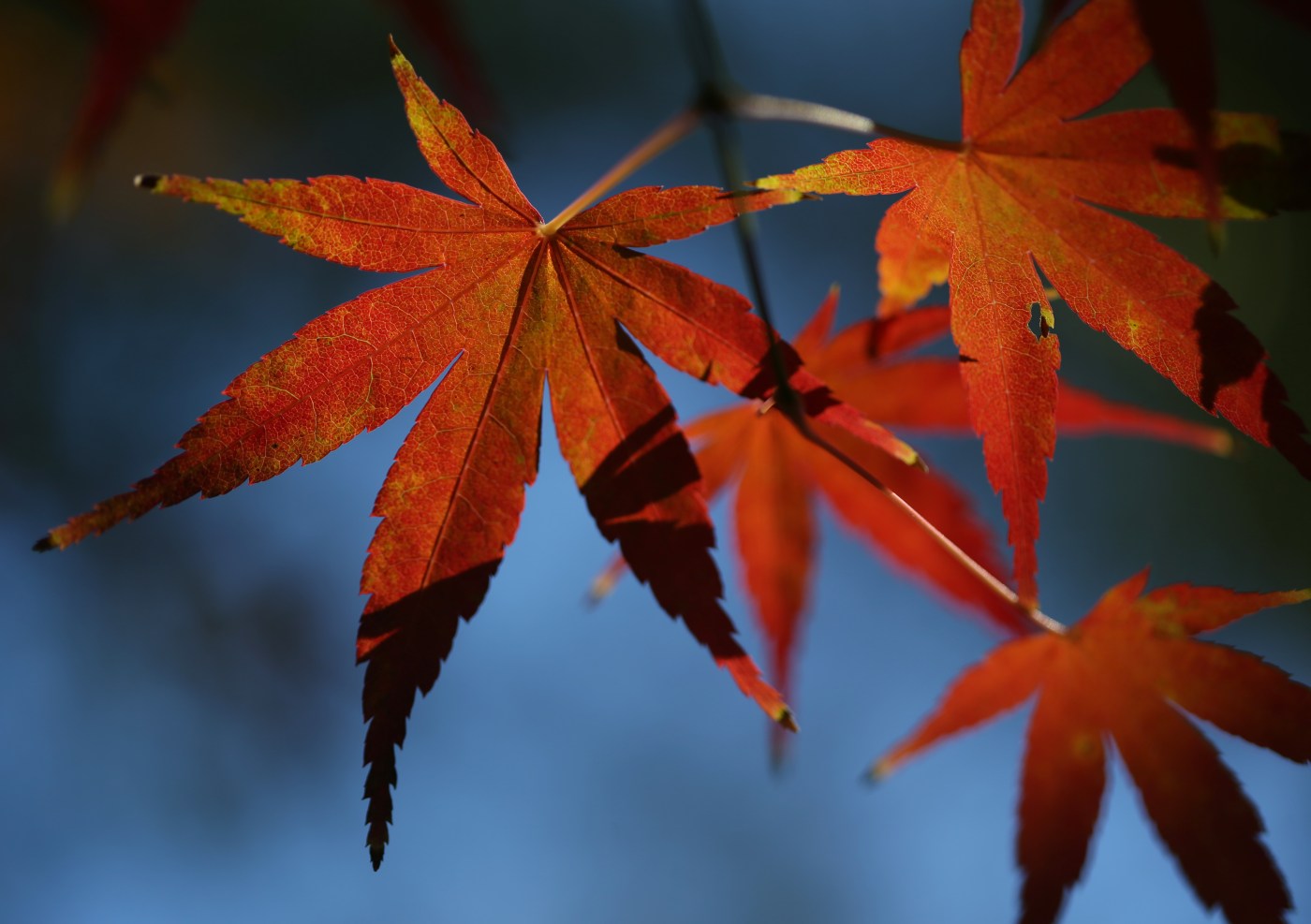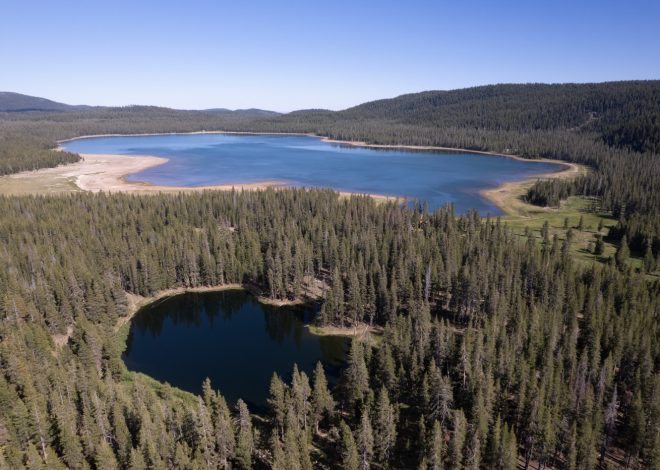
California’s fall color: Where to go leaf-peeping in the Golden State
We’ve got something to say to all of you East Coast and Midwest transplants who start moaning every autumn about missing real seasons:
We do too have fall color in California!
“It’s dramatic in a different way,” said Lara Kaylor, a Mammoth Lakes travel journalist who edits the go-to website for Golden State leaf-peepers, CaliforniaFallColor.com. “Instead of huge swaths of color along the highway, you get these vibrant patches up against majestic landscapes, like yellow and orange aspens at the base of beautiful mountains.”
And our fall color season lasts longer than most in North America because of the wide variances in elevation across the state, Kaylor and arborists say. You can find color somewhere in California from September through December. If you miss the peak show at one elevation, just head lower for a brilliant display.
By contrast, autumn color on the East Coast descends by latitude from the north. When it’s gone, it’s gone.
Aspens and ground cover put on a showy display in Carson Pass and Hope Valley, along Highway 88 south of Tahoe. (California Travel and Tourism Commission photo via the Associated Press)
For Bay Area enthusiasts, fall color can be as close as the maples and willows along the highway to Santa Cruz, the flame-colored Chinese pistache and liquidambar trees in a neighbor’s yard or a weekend away in California’s foothills or mountains. The state’s legendary Mediterranean climate also helps create a more varied, longer lasting show.
And it doesn’t take much to declare the season underway. Color spotter Philip Reedy headed up to the Highway 50 and American River area in mid-September — too early for much color at that level — and wrote on the California Fall Color website: “I did find one leaf that wasn’t willing to wait for fall to officially begin.” He took a photo of the brilliant red leaf and posted it.
That enthusiasm is to be expected, Kaylor said. “It’s a special time of year, and it goes so fast,”
Here are some favorite spots for local excursions and longer road trips recommended by the California Fall Color website’s more than 100 “color spotters,” plus arborists and tourism officials. Besides posting photos, the color spotters offer thoughts on best hikes and best drives for enjoying autumn’s hues. Keep in mind: Look online or call ahead to check on the status of color in the region you’ll be visiting.
Fall colors are in full glory at the historic Calistoga Inn Restaurant and Brewery, Sunday, Nov. 26, 2023, in Calistoga, Calif. (Karl Mondon/Bay Area News Group)
Eastern Sierra (Inyo and Mono counties)
Related Articles
5 great spots to catch the fall bird migration in the Bay Area
Get to know the Bay Area birds of autumn
Billionaire battle: Musk blasts Khosla over Martins Beach, curses him on social media
For 75 years, Camp Hi-Sierra has given South Bay scouts an outdoor adventure
New wilderness proposal could put rock climbers at risk, US senators’ letter says
California’s season of color typically starts at the highest elevations in these counties. “This year was especially exciting with a cold weather snap the week before the autumn equinox, setting things up to dramatically change in the next few weeks,” the website report on Mono says. In Inyo County, a color spotter wrote that the yellows were covering the hillsides and the shorelines around Lake Sabrina and South Lake. Color is at “near peak” level now, so it could be gone by mid-October. Where: Along Highway 395
Lake Tahoe, Northern Sierra
South of Lake Tahoe, in the Hope Valley region where Highways 88 and 89 converge, aspen groves, willows and cottonwood flourish. Foliage fans say the colors were just “shyly showing” up in these parts in late September. At Bucks Lake, a color spotter reported that “mountain ash has turned color to red and orange as a usual first color changer. The quaking aspens are on the verge of their color change. On Big Creek Road to Bucks Lake, the bigleaf maples are beginning to turn.” Where: Hope Valley/Carson Pass, Lake Tahoe, Highway 89.
Southern California mountains
After the color starts to turn in the north, Southern California’s higher elevations typically are next to join the show. The 2023 report — which, depending on weather, may bear no resemblance to this year’s color display — noted Big Bear peaking in October and “colors galore” in early November at Lake Arrowhead. Down at the lower elevations, staffers at the Los Angeles County Arboretum and Botanic Garden noted their peak came in mid-December. Where: San Bernardino, San Gorgonio, San Jacinto and Laguna mountains, Angeles National Forest.
Shasta Cascade (Plumas County, Lassen, Shasta Trinity)
“One of the first signs of fall in Plumas County can be found in Quincy, when the Virginia Creeper makes its debut with vibrant reds” all over town, the Fall Color report says. Pick up a free “LeafPeeper” sign at one of the tourist centers to put in your rear window. It warns other drivers that you’ll be stopping frequently to ooh and aah over the aspens, dogwoods, cottonwoods and bigleaf and silver maples. Where: This region includes Lassen Volcanic National Park, the national forest at Shasta-Trinity, the Trinity Alps and the areas near Redding and Chico.
Yosemite, Sequoia, Kings Canyon
Late Oct. color on the Yosemite Valley floor frames the majestic Half Dome at the national park. (Ben Margot/AP archives)
Foliage experts consider the Western and Southern Sierra regions, home to these three national parks, great places to find the showy leaves of autumn. Look for dogwoods in red shades and oaks in deep orange, but typically not until November. Color spotter Angie Plaisted, who notes that Yosemite “never disappoints,” found spectacular hues in early November 2023 at the park.
Gold Country (Calaveras, Nevada, El Dorado counties)
Amid the giant sequoias in Calaveras Big Trees Park, visitors can see dogwoods in red and bigleaf maples transitioning to yellow and gold along the North Grove and South Grove trails. Farther north, aspens can be seen along the roadways. According to the fall color site, Nevada City and Grass Valley had brilliant Japanese maples, black oaks and gum trees from October into close to Thanksgiving last year. And a pair of Placerville/Camino leaf peepers reported that a mid-November rainstorm made Apple Hill’s fall colors astonishingly bright. Where: Calaveras, Apple Hill, Nevada City and Grass Valley.
Butano State Park (San Mateo County)
Colorful autumn leaves glisten in the November sun in Pescadero, not far from Butano State Park. (Karl Mondon/Bay Area News Group archives)
Old-grove redwoods provide a striking evergreen contrast to changing colors of bigleaf maple, California sycamore, willows and poison oak, with vines up to 30 feet. Maple typically is an early changer, swinging from yellow to gold; willows are more likely to change in December and January, leaf peepers say. Where: Off Highway 1, southeast of Pescadero.
Henry W. Coe State Park (Santa Clara and Stanislaus counties)
At 87,000 acres, this is California’s largest state park. Look for bigleaf maples turning bright yellow, and black oaks in subdued purples and some reds. Madrone trees can sprout reddish orange berries, with trunks in brownish orange. Poison oak turns a flaming red, but is still dangerous to touch. Where: On East Dunne Avenue in Morgan Hill, off Highway 101.
An amateur photographer in Brentwood takes pictures of a fruit orchard in this archival image. (Jose Carlos Fajardo/Bay Area News Group archives)
TIPS FOR CALIFORNIA LEAF-PEEPING TRIPS
— The higher the elevation, the earlier the fall color. Experts say a good rule of thumb to remember is that color descends by 500 to 1,000 feet every week. So if it’s peak viewing time at the 8,500-foot elevation in the Eastern Sierra, look for the 7,500-foot locations to peak in a week.
— Know before you go. Social media has been great for fans of fall foliage, with lots of travelers posting updates to sites such as www.californiafallcolor.com. Check the daily reports before you head out. If you’re making advance plans, look up last year’s reports for guidance.
— Innkeepers in many California counties — Plumas, Inyo, Mono, Shasta and El Dorado among them — offer autumn lodging and dining deals. Check the CaliforniaFallColor website or do an online search for the county name and “tourism.”
Fog-shrouded trees made for a dreamy fall scene one year at Lake Vasona in Los Gatos. (Jim Gensheimer/Bay Area News Group archives)
3 TYPES OF FALL COLOR
Mother Nature’s display isn’t all about maples. You can find fall color wherever you find trees and other plantings, experts say.
Native: In California, the traditional showy display is provided by such natives as the aspen, the black oak, the bigleaf maple, the California sycamore, the Pacific dogwood and the Pacific madrone.
Agricultural: The state’s rich agricultural heritage adds to the autumnal mix. Look for color in apricot, plum and walnut tree orchards throughout the state as well as on cabernet and chardonnay vines and other varietals in the wine regions.
Landscaped: Non-native trees (aka “exotics”) provide lots of close-to-home color. Keep an eye out for the leaves of the Chinese pistache, liquidambar, birch and gingko trees in the urban landscape.


